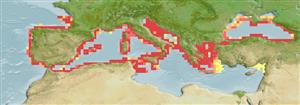>
Callionymiformes (Dragonets) >
Callionymidae (Dragonets)
Etymology: Callionymus: Greek, kallion, comparative of kallos = beautiful + Greek, onyma = name; with a better name .
Environment: milieu / climate zone / depth range / distribution range
Ökologie
seewasser demersal. Subtropical; 46°N - 35°N, 10°W - 42°E
Eastern Atlantic and Mediterranean Sea: Portuguese coast to as far north as Lisbon; also known from the northern Mediterranean including the Adriatic, Aegean and Black seas as well as Lebanon and Israel.
Size / Gewicht / Alter
Maturity: Lm ? range ? - ? cm
Max length : 14.0 cm TL Männchen/unbestimmt; (Ref. 5968); 10.0 cm TL (female)
Kurzbeschreibung
Bestimmungsschlüssel | Morphologie | Morphometrie
Rückenflossenstacheln (insgesamt) : 4; Rückenflossenweichstrahlen (insgesamt) : 6 - 7; Afterflossenweichstrahlen: 9.
Inhabits shallow waters with sandy bottoms, occasionally found at a depth of 100 m. Feeds on small bottom invertebrates, mainly worms and crustaceans (Ref. 5968).
Life cycle and mating behavior
Maturities | Fortpflanzung | Spawnings | Egg(s) | Fecundities | Larven
Fricke, R., 1986. Callionymidae. p. 1086-1093. In P.J.P. Whitehead, M.-L. Bauchot, J.-C. Hureau, J. Nielsen and E. Tortonese (eds.) Fishes of the North-eastern Atlantic and the Mediterranean. UNESCO, Paris. Vol. 3. (Ref. 5968)
IUCN Rote Liste Status (Ref. 130435)
Bedrohung für Menschen
Harmless
Nutzung durch Menschen
Tools
Zusatzinformationen
Download XML
Internet Quellen
Estimates based on models
Preferred temperature (Ref.
123201): 12.1 - 19.4, mean 17.1 °C (based on 234 cells).
Phylogenetic diversity index (Ref.
82804): PD
50 = 0.5000 [Uniqueness, from 0.5 = low to 2.0 = high].
Bayesian length-weight: a=0.00891 (0.00478 - 0.01661), b=2.69 (2.54 - 2.84), in cm total length, based on LWR estimates for this species & Genus-body shape (Ref.
93245).
Trophic level (Ref.
69278): 3.3 ±0.40 se; based on food items.
Widerstandsfähigkeit (Ref.
120179): hoch, Verdopplung der Population dauert weniger als 15 Monate. (Preliminary K or Fecundity.).
Fishing Vulnerability (Ref.
59153): Low vulnerability (10 of 100).
Nutrients (Ref.
124155): Calcium = 115 [26, 356] mg/100g; Iron = 1.35 [0.51, 4.87] mg/100g; Protein = 3.17 [0.00, 6.98] %; Omega3 = 0.328 [0.142, 0.735] g/100g; Selenium = 18.4 [3.6, 55.3] μg/100g; VitaminA = 19.5 [6.1, 59.7] μg/100g; Zinc = 1.04 [0.53, 2.10] mg/100g (wet weight);
